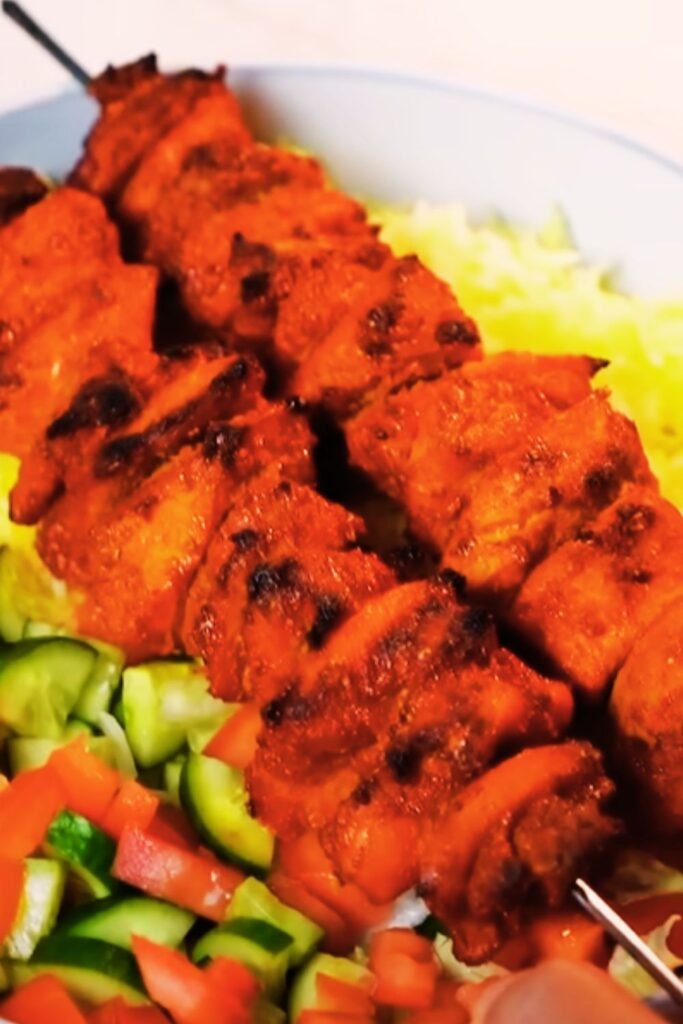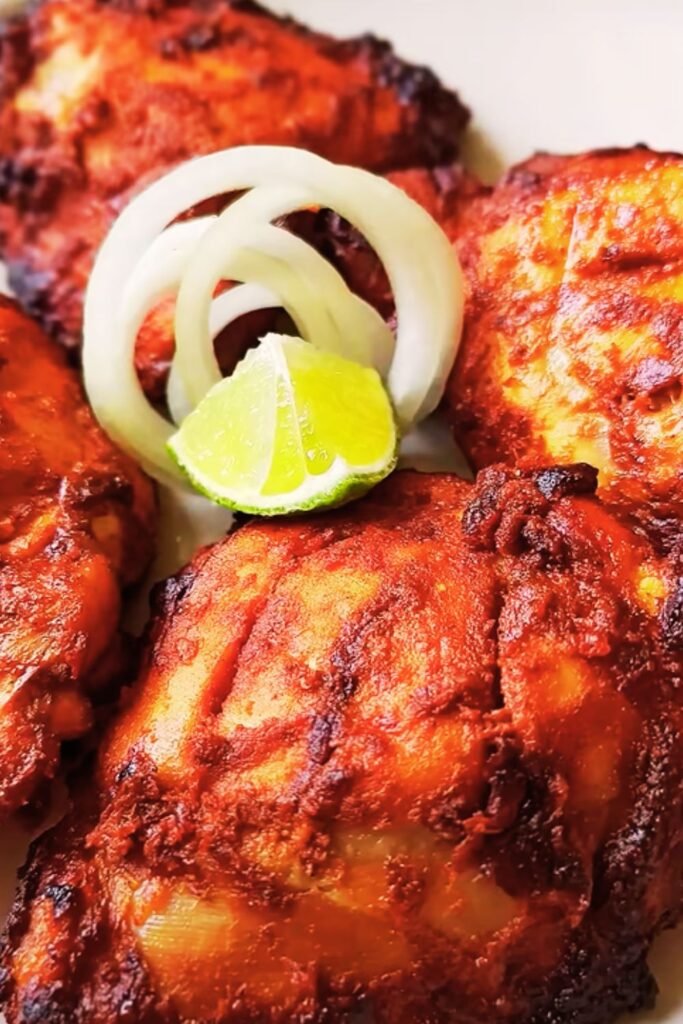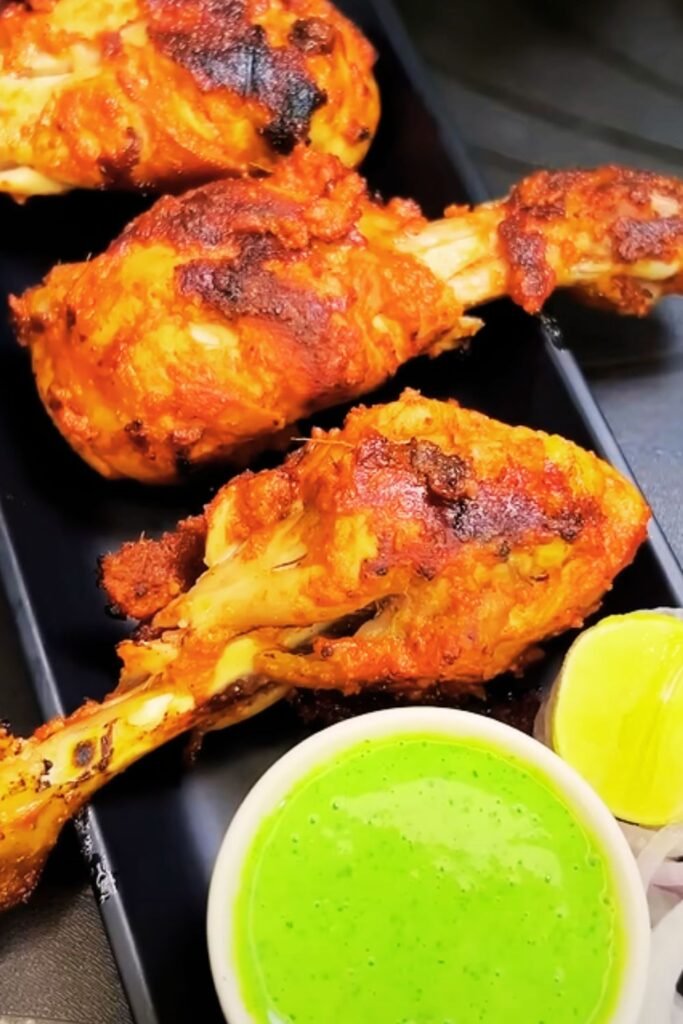There’s something almost magical about that first bite of perfectly grilled tandoori chicken—the crispy, slightly charred exterior giving way to juicy, tender meat infused with a symphony of aromatic spices. I’ve spent years perfecting my tandoori chicken recipe, and today I’m sharing all my secrets so you can recreate this beloved Indian classic right in your backyard.
Tandoori chicken gets its name from the traditional clay oven (tandoor) in which it’s typically cooked. While most of us don’t have access to an authentic tandoor at home, I’ll show you how to achieve those same incredible flavors and textures using your regular grill. Trust me, after mastering this recipe, you’ll never look at grilled chicken the same way again!
What Makes Tandoori Chicken Special?
Tandoori chicken isn’t just another grilled chicken recipe—it’s a celebration of bold flavors and ancient cooking techniques. The distinctive characteristics come from three key elements:
The Marinade: A rich blend of yogurt and spices that tenderizes the meat while infusing it with deep flavor The Spices: The signature red color and complex flavor profile come from a carefully balanced spice mixture The Cooking Method: High heat cooking that creates a charred exterior while keeping the inside perfectly juicy
I still remember my first attempt at making tandoori chicken—let’s just say the smoke alarm got more action than my taste buds! But through trial and error (and setting off a few more alarms), I’ve cracked the code to restaurant-quality tandoori chicken that you can easily make at home.
Essential Ingredients for Authentic Tandoori Chicken
Before we dive into the preparation, let’s talk about the ingredients that give tandoori chicken its distinctive flavor and appearance:
The Foundation
- Chicken: I prefer bone-in chicken thighs and legs as they stay juicier during high-heat cooking
- Yogurt: Full-fat plain yogurt creates the perfect marinade base that tenderizes the meat
- Lemon juice: Adds brightness and helps tenderize the chicken
The Spice Mix
- Kashmiri red chili powder: Provides the signature color with moderate heat
- Garam masala: A warming spice blend that adds depth
- Turmeric: Offers earthy notes and beautiful yellow color
- Cumin: Brings nutty, earthy flavors
- Coriander: Adds citrusy, floral notes
- Ginger and garlic paste: The aromatic foundation of the marinade
The Aromatics
- Fresh cilantro: For garnishing and fresh flavor
- Red onions: Traditionally served alongside
- Lemon wedges: For squeezing over the finished dish

Some recipes call for food coloring to achieve that bright red color, but I find that good quality Kashmiri chili powder provides beautiful color naturally without artificial additives. If you can’t find Kashmiri chili powder, you can substitute regular chili powder with a touch of paprika.
The Secret to Perfect Tandoori Chicken: Double Marination
If there’s one technique that elevates good tandoori chicken to great tandoori chicken, it’s double marination. This two-step process ensures that flavor penetrates deep into the meat:
First Marinade: A simple mixture of lemon juice, ginger-garlic paste, and salt that creates the foundation Second Marinade: The yogurt-based spice mixture that adds complexity and tenderizes the meat
The acids in both marinades work to break down the proteins in the chicken, resulting in meat that’s incredibly tender while remaining succulent after grilling.
Detailed Recipe: Grilled Tandoori Chicken
Ingredients
For 4-6 servings:
- 8 bone-in, skin-on chicken pieces (thighs and drumsticks work best)
- 2 tablespoons fresh lemon juice
- 1 tablespoon ginger paste
- 1 tablespoon garlic paste
- 1 teaspoon salt
For the second marinade:
- 1 cup plain full-fat yogurt (Greek yogurt works well too)
- 2 tablespoons Kashmiri red chili powder
- 1 tablespoon garam masala
- 1 teaspoon ground cumin
- 1 teaspoon ground coriander
- 1 teaspoon turmeric powder
- 1 teaspoon freshly ground black pepper
- 1 tablespoon neutral oil (like vegetable or grapeseed)
- Salt to taste
- 1 tablespoon dried fenugreek leaves (kasoori methi) – optional but highly recommended
For serving:
- Fresh cilantro, chopped
- Lemon wedges
- Sliced red onions
- Cucumber raita (recipe below)
Preparation Method
Step 1: Prepare the Chicken
- Make deep slashes in the chicken pieces with a sharp knife. This allows the marinade to penetrate the meat.
- Clean and pat dry the chicken pieces thoroughly.
Step 2: First Marinade
- In a large bowl, combine lemon juice, ginger paste, garlic paste, and salt.
- Add the chicken pieces and rub this marinade all over, making sure to get it into the slashes.
- Let the chicken marinate for 30 minutes.
Step 3: Second Marinade
- In another bowl, whisk together yogurt, Kashmiri red chili powder, garam masala, cumin, coriander, turmeric, black pepper, oil, and salt.
- If using dried fenugreek leaves, crush them between your palms and add them to the mixture.
- Add the chicken (including any liquid from the first marinade) to this yogurt mixture.
- Mix thoroughly, making sure every piece is well coated.
- Cover and refrigerate for at least 4 hours, preferably overnight.
Step 4: Prepare for Grilling
- Remove the marinated chicken from the refrigerator 30 minutes before cooking to allow it to come to room temperature.
- Preheat your grill to medium-high heat (around 400°F/200°C).
- Oil the grill grates to prevent sticking.
Step 5: Grill the Chicken
- Place the chicken pieces on the grill, shaking off excess marinade.
- Grill with the lid closed for about 5-7 minutes per side.
- Turn occasionally and baste with a little oil or leftover marinade (if saving some separately for this purpose).
- Cook until the internal temperature reaches 165°F (74°C) and the outside has nice char marks.
- Let the chicken rest for 5-10 minutes before serving.

Serving Suggestions
Serve hot garnished with:
- Fresh chopped cilantro
- Lemon wedges for squeezing
- Thinly sliced red onions
- A side of cucumber raita
- Naan bread or basmati rice
Quick Cucumber Raita Recipe
Raita is the perfect cooling accompaniment to spicy tandoori chicken. Here’s my simple recipe:
Ingredients
- 1 cup plain yogurt
- 1 medium cucumber, grated and excess water squeezed out
- 2 tablespoons fresh mint leaves, finely chopped
- 1 small green chili, finely chopped (optional)
- ½ teaspoon roasted cumin powder
- Salt to taste
Method
- Whisk the yogurt until smooth.
- Fold in the grated cucumber, mint leaves, and green chili (if using).
- Season with roasted cumin powder and salt.
- Refrigerate for at least 30 minutes before serving.
Common Problems and Solutions When Making Tandoori Chicken
| Problem | Possible Cause | Solution |
|---|---|---|
| Chicken is dry | Overcooked or using only breast meat | Use bone-in thighs/legs and monitor internal temperature closely |
| Not enough flavor | Insufficient marination time | Marinate longer (minimum 4 hours, ideally overnight) |
| Burnt exterior, raw interior | Grill temperature too high | Lower heat and cook longer, use indirect grilling method |
| Pale color | Not enough Kashmiri chili powder | Increase the amount of Kashmiri chili powder |
| Marinade falls off during grilling | Excess marinade not removed | Shake off excess marinade before grilling |
| Spice level too high | Too much chili powder | Balance with more yogurt or use milder chili powder |
| Chicken sticking to grill | Grill not properly oiled | Oil the grates well before grilling |
The Science Behind Perfect Tandoori Chicken
Understanding the science behind the recipe helps achieve better results:
Acid Tenderization: The lemon juice and yogurt in the marinade contain acids that break down proteins, making the meat more tender.
Dairy Enzymes: Yogurt contains natural enzymes that further tenderize the chicken while adding richness.
Spice Blooming: Oil in the marinade helps bloom the fat-soluble flavor compounds in the spices, enhancing their taste.
Maillard Reaction: The high heat of grilling causes a Maillard reaction—the browning process that creates complex flavors on the surface of the meat.
Tips for Taking Your Tandoori Chicken to the Next Level
After years of making tandoori chicken, I’ve discovered a few tricks that can elevate your dish:
- Toast your spices: Before adding to the marinade, toast whole spices in a dry pan until fragrant, then grind them for more intense flavor.
- Use mustard oil: If available, replace regular oil with mustard oil in the marinade for an authentic flavor (just be sure to heat it until it smokes first to reduce the pungency).
- Try the skewer test: To check if your chicken is done, insert a skewer—if it goes in easily and the juices run clear, it’s ready.
- Rest the meat: Allow the chicken to rest for 5-10 minutes after grilling to redistribute the juices.
- Baste with ghee: In the last few minutes of grilling, baste with melted ghee (clarified butter) for extra richness.

Healthier Variations of Tandoori Chicken
If you’re looking for a lighter version, try these modifications:
- Skinless chicken: Remove the skin before marinating to reduce fat content
- Greek yogurt: Use fat-free Greek yogurt instead of full-fat yogurt
- White meat option: Use chicken breast but reduce cooking time to avoid drying out
- Oven-baked version: Bake in a 425°F (220°C) oven on a wire rack over a baking sheet for a less fatty option
Frequently Asked Questions About Tandoori Chicken
Q: Can I make tandoori chicken without a grill? Yes! You can use an oven broiler set to high. Place chicken on a rack over a foil-lined baking sheet and cook about 5-6 inches from the heat source, turning occasionally.
Q: Why is my tandoori chicken not as red as restaurant versions? Many restaurants use food coloring. For natural color, increase the amount of Kashmiri red chili powder or add a bit of paprika to your marinade.
Q: Can I use boneless chicken? Absolutely! Boneless thighs work great but reduce cooking time to about 4-5 minutes per side. Boneless breast works too but is more prone to drying out.
Q: How long can I store the marinated chicken before cooking? The marinated chicken can be refrigerated for up to 48 hours, which can actually improve the flavor development.
Q: Is there a dairy-free alternative for the yogurt in the marinade? Yes, coconut yogurt makes an excellent dairy-free substitute and adds a subtle sweetness that works well with the spices.
Q: My marinade keeps burning on the grill. How do I prevent this? Shake off excess marinade before placing chicken on the grill, and consider using an indirect grilling method (hot side/cool side) to give you more control.
Q: Can I freeze marinated tandoori chicken? Yes! Freeze it in the marinade for up to 3 months. Thaw completely in the refrigerator before grilling.
A Brief History of Tandoori Chicken
Tandoori chicken has a fascinating history that dates back to the 1940s in Peshawar (now part of Pakistan). The dish was reportedly invented by Kundan Lal Gujral, who later opened the famous Moti Mahal restaurant in Delhi after partition.
Originally cooked in clay tandoor ovens at extremely high temperatures (often over 900°F/480°C), tandoori chicken became popular throughout South Asia and eventually gained international fame. The traditional method involves skewering marinated chicken and lowering it vertically into the tandoor, where it cooks quickly while developing its characteristic smoky flavor.
Today, tandoori chicken is enjoyed worldwide, with variations adapted to local tastes and cooking methods. The home grilling method we’re using captures much of the authentic flavor while making this delicious dish accessible to everyone.
Nutritional Information
| Nutrient | Amount per Serving |
|---|---|
| Calories | 320 |
| Protein | 28g |
| Fat | 18g |
| Saturated Fat | 5g |
| Carbohydrates | 8g |
| Fiber | 1g |
| Sugar | 4g |
| Sodium | 620mg |
| Calcium | 80mg |
| Iron | 2mg |
Note: Values are approximate and based on using skin-on chicken thighs and legs with full-fat yogurt marinade.
Final Thoughts on Mastering Tandoori Chicken
After years of experimenting with different techniques and ingredients, I’ve found that patience is truly the key to exceptional tandoori chicken. Don’t rush the marination process—those hours of waiting are when the magic happens as the spices and acids work their way into the meat.
Remember that tandoori chicken is more than just a dish; it’s a celebration of bold flavors and cooking traditions passed down through generations. With this recipe and techniques in your culinary arsenal, you’ll be able to create restaurant-quality tandoori chicken that will impress family and friends alike.
From my kitchen to yours, I hope this guide helps you create memorable meals that bring a touch of India to your table. The beauty of cooking is in making each recipe your own, so don’t be afraid to adjust the spice levels or experiment with different accompaniments to suit your taste.
Q&A Section
Q: What’s the biggest mistake people make when preparing tandoori chicken? The biggest mistake is rushing the marination process. For truly flavorful and tender tandoori chicken, you need to allow at least 4 hours, but preferably overnight, for the marinade to work its magic. The acids and enzymes in the marinade need time to break down the proteins in the meat.
Q: How do I know when my tandoori chicken is perfectly cooked? The most reliable method is using a meat thermometer—chicken is safely cooked when it reaches an internal temperature of 165°F (74°C). Without a thermometer, make a small cut near the bone—the juices should run clear with no pinkness, and the meat should no longer be pink at the bone.
Q: Can I prepare tandoori chicken ahead of time for a party? Absolutely! In fact, tandoori chicken is perfect for entertaining because you can prepare everything in advance. Marinate the chicken the day before, and when guests arrive, you just need to grill it. You can even pre-grill it 80% of the way, then finish it off just before serving for perfectly hot, fresh chicken.
Q: What side dishes pair well with tandoori chicken? Beyond the traditional raita and naan, tandoori chicken pairs beautifully with:
- Pulao or jeera (cumin) rice
- Kachumber salad (diced cucumber, tomato, and onion)
- Roasted vegetables like bell peppers and zucchini
- Mint chutney
- Mango chutney for a sweet counterpoint
Q: How spicy is authentic tandoori chicken supposed to be? Traditional tandoori chicken has a moderate heat level that’s balanced by the cooling yogurt in the marinade. However, spice levels can vary greatly by region and personal preference. My recipe provides a moderate heat that most people enjoy, but you can easily adjust the chili powder up or down to suit your taste.
Q: Can I use the same marinade recipe for other meats or vegetables? Yes! The tandoori marinade works wonderfully with:
- Fish fillets (reduce marination time to 30 minutes)
- Paneer (Indian cottage cheese)
- Mushrooms, bell peppers, onions, and other vegetables
- Lamb chops (marinate overnight) Just adjust cooking times according to what you’re grilling.